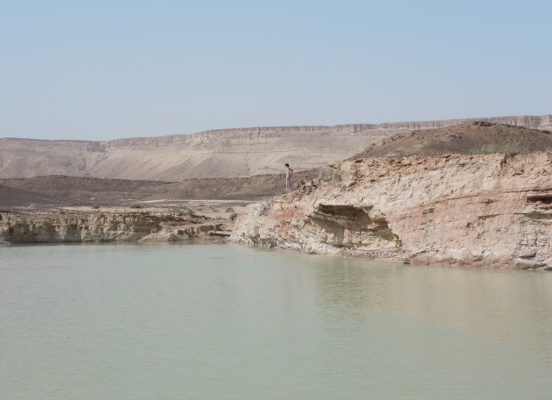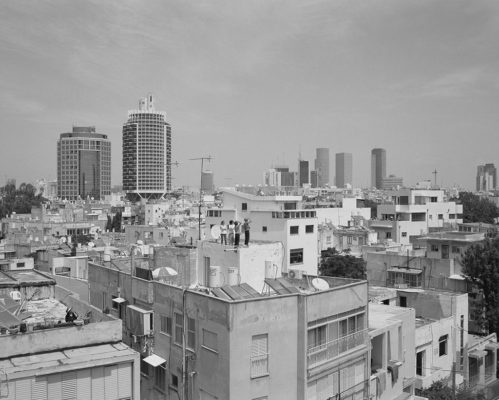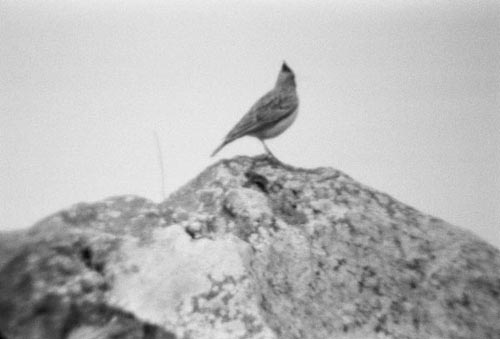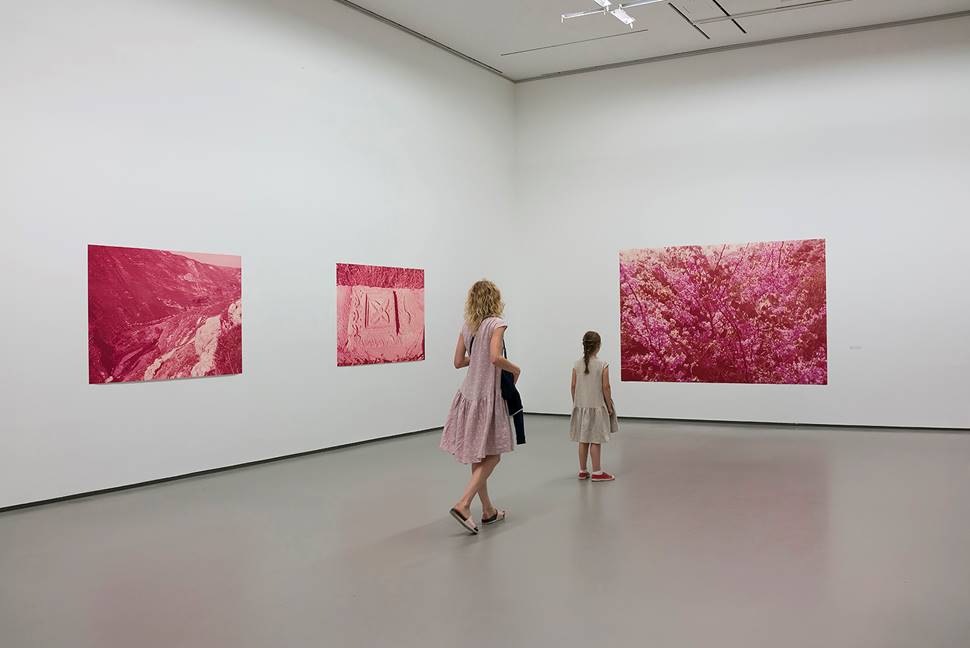The craft of photography is often compared to the act of storytelling, and it is understandable why the comparison is so tempting to make. If in civilizations past a raconteur would sit around the fire and tell his fellow men tales of their own heritage, in modern societies photographers often take up the same role — they cast their gaze on a culture, hold the cameras to their eyes and through a click of their fingers, capture a moment in time that encapsulates the essence of the society they are part of.
Israeli photographer Sharon Ya’ari has done just that over the decades, returning to the familiar landscapes of the country and documenting them repeatedly. But while his rich body of work does weave countless tales about this small patch of disputed territory in the Levant, Ya’ari himself should not be mistaken for a storyteller. If anything he is an archivist of emotions, systematically and calculatedly turning his persistent gaze on local streets and fields until his eye yields from them exact sentiment that they evoke.
His name has become synonymous with landscape photography thanks to timeless, iconic images the artist crafted over the years of Israel’s countryside as well as eerie shots of abandoned nature. But the first thing Ya’ari insists on telling me when I step into his studio in south Tel Aviv is that he is not a landscape photographer. “Every time I’m told that I’m a landscape photographer I’m surprised. I think: ‘What? Me? I have nothing to do with the landscape.’’’

Ramon Crater
2012
The photographer says that the reason such shots have dominated his opus is that he is inadvertently drawn to simple, seemingly lackluster spots. “The arbitrariness, the day to day – I am very preoccupied by that. It’s important for me to take pictures of places you wouldn’t associate very strongly with other things. Not a burial site, not some holy site. It’s very hard to find places like that in Israel; wherever you turn there is some monument,” he explains.
And indeed, the scenes he focuses his lense on are such that one passes by every day: Quiet backyards, empty gas stations, intercity roads clogged by the early morning commute. “I chose to go for this interim state where I take pictures of places that seem familiar but when you look at them you feel like you can’t entirely recognize them for what they are. I want you to feel like it’s just some random place, nothing special,” Ya’ari tells me.
Getting used to the absence
Man’s race against the clock is a recurring theme in the artist’s work. On his road trips throughout the country, Ya’ari finds himself driving back to the same places. Like a coroner at the scene of an accident, he observes the decay that weather and mankind force on natural habitats. “This is happening more frequently in more places in Israel,” he observes.
As we sift together through his earlier works, he brings to my attention a photograph of a ficus tree that was planted outside a police station in Tel Aviv. Next to it, he points at a picture he took of the exact same spot years later. The tree had been uprooted, but remnants of its bark and sprigs remained – telltale signs of a living thing that once existed and suddenly disappeared. “At first it was a completely banal picture. But then someone decided to kill this tree. Look, these leaves are still there, they don’t know that they are dead yet. I see something like that and I get excited. Suddenly, a photograph that was pointless is filled with meaning.”
Ya’ari says that in between snapping and juxtaposing the two images, he carried out a small investigation. “An entire scene unfolded. I went to nearby garages and asked the people working there: ‘What happened to the tree?’ and they answered – ‘there was never a tree here.’ This is about getting used to the absence, to the lack. To a vacuum that is created.”
In another trademark snapshot of his, a black-and-white picture of Tel Aviv taken from above, the skyscrapers that were erected in the city over the years jut out, chipping at the skyline like insistent reminders of what the metropolis was once like when it was devoid of the buildings.

Tel Aviv
2006
While other, more traditional photographers are in pursuit of a decisive, definitive moment, Ya’ari is more interested in trying to strike a fragile balance between the beauty of what still stands and the loss that is gnawing away at his surroundings. “It doesn’t come from an aesthetic viewpoint in the formal sense of the word,” he says of his inspiration. “It is driven by a meeting point with a certain subject. I’m interested in that meeting.
Sometimes I can stand in front of something and it kind of beckons to me – ‘Come, take my picture.’ And I do, but I know in advance that in most cases, nothing will come of it. But on the other hand some images seem banal, I don’t even understand why I photographed them, but the passage of time charges them with meaning. Either something happened in that specific place [where I took the picture] or something happened within me when I look at it.”
‘Something has to go wrong’
Some of the photographer’s later works, like the peaceful but surrealist ‘Bridge with Flowers,’ sport strange marks that occurred when the development process went awry. Ya’ari admits that he actually prefers them to the undamaged portraits. The best part of his work process, he says, is when the unexpected makes itself known and push him off the predicted path. “Something has to surprise me, something has to happen, something has to go wrong. Suddenly someone comes while I take the picture, a conversation starts, and my whole trajectory is changed.”
A closer look at his crafts reveals that the flirtation with disaster or a looming end were always there. He delved into the theme of loss in his 2006 solo exhibition at the Tel Aviv Museum of Art, where he coined the term “Hope for Long Distance Photography” and used the expression to describe a series of morose works displaying birds, trees and swamps that seemed to belong in a faraway land and suggested a slow separation from beloved territories.

Hope for Long Distance (Bird)
2006
“I wasn’t afraid of the concept of time when I was younger, maybe I’m more scared of it today. There is something about expectation and disappointment that is very related to photography, especially here in Israel. Every wave of immigrants that came here, from the 19th century onwards, experienced disappointment. There is something pleasurable about having this expectation,” he reflects. “There is an expectation that I can’t really fulfill, and it’s related to the passage of time and the hope that is still harbored.”
Before we part ways, I ask Ya’ari why he never takes photographs of the most intimate landscape: His own home. In reply, the photographer shows me a catalogue of candid and oddly moving works dating back to over a decade ago, which he named “500 Meter Radius.”
“If there is only one definition by which I would have to characterize my own work, it would be the return home. When I made ‘500 Meter Radius,’ it came from a very trivial trigger. I had a baby and he would wake up at 5 AM. I would take him out at 4:30 in the morning to let his mother sleep. We would walk together and I would go into backyards and take pictures. He was my alibi,” he jokes.
“This is a very specific example,” the photographer acknowledges. “But it exists in all of my works. Think about a landscape for a second,” he requests. “It’s never inside of you, it’s always growing further away from you. That’s why I don’t photograph landscapes, I take pictures of an environment. I’m inside things, they are mine.”
Discover & Collect Sharon Ya’ari’s works here.
Joy Bernard is a senior news editor at Israel’s leading English-language daily Haaretz. Based in Tel Aviv, she writes about politics, arts and culture in the Middle East for various publications.

